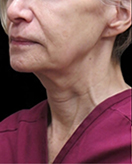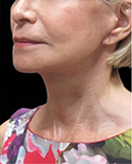laViv
Conveniently located to serve the areas of New York, NY

Fibroblasts are specialized skin cells that produce collagen and play a key role in maintaining skin health and beauty. During the aging process, there is a natural reduction in fibroblasts, leading to decreased collagen production. When collagen is depleted, the underlying structure of the skin becomes lax, losing resiliency and elasticity, and allowing wrinkles and folds to form. LAVIV™ is an FDA-approved autologous cell therapy that uses a patient’s own fibroblast skin cells to increase collagen production and diminish the signs of facial aging.
Contents [hide]
Procedure
LAVIV™ is the first and only FDA-approved personalized cellular therapy that uses the patient’s own collagen-producing fibroblast cells to improve the appearance of moderate to severe nasolabial folds. During LAVIV™ treatment, patient skin samples are cultivated to produce new fibroblast cells. These living cells are injected into the skin, where they can help to produce collagen. By replacing lost collagen, fibroblasts help to reinforce the skin’s structure, smooth folds and wrinkles, and leave the face looking younger.
During your first appointment, Dr. Levine will take small skin samples from behind your ear. These skin samples are sent to a laboratory, where they are cultivated using a state-of-the-art process that will produce millions of new fibroblast cells over the next three months. Once it is ready, Dr. Levine will administer your personal LAVIV™ therapy during a series of 3 treatments, spaced 3 to 6 weeks apart.*
Other Procedures
LAVIV™ is unique because it is made from your own fibroblast cells. Unlike superficial fillers which smooth facial lines by filling in wrinkles, LAVIV™ works in the deeper layers of skin to replace lost collagen. Collagen is a key skin component that provides structure and support to keep skin looking fresh, youthful, and supple.
Treatment Areas
LAVIV™ is FDA-approved to treat moderate to severe “smile lines” between the nose and mouth (nasolabial folds). Off label uses include fine lines above the lips, on the forehead, on the cheeks and elsewhere on the face.
Safety
LAVIV™ is made for you from your own skin cells. Side effects from LAVIV™ are typically mild and rare. Temporary redness and swelling at the injection site is possible. These effects usually resolve within a few days and can be covered with makeup if desired. LAVIV™ should not be used by patients who are allergic to gentamicin, amphotericin, dimethyl sulfoxide, or bovine materials (products made from cattle) since these materials are used during processing. Dr. Levine will discuss with you any possible side effects and answer any questions that you may have about safety.
LAVIV® is best administered by a qualified dermatologist or plastic surgeon with an understanding of proper technique and safety. Both Dr. Jody Levine and Dr. Elie Levine have expertise in administering LAVIV® and would be happy to answer your questions about whether LAVIV® is right for you.
Results
Results vary according to the individual, but most people notice improvements within a month after treatment.*
LAVIV™ is administered in 3 separate treatments, spaced 3 to 6 months apart. Studies show that results from LAVIV™ therapy are present a full 6 months after the final treatment.*
Other Procedures
Yes. Various dermal fillers and other cosmetic injectables, such as BOTOX®, are often used concurrently to treat a variety of facial areas. Additionally, different types of fillers can be used synergistically as part of advanced layer techniques. For example, Dr. Levine may elect to use one filler in the deep dermis to provide structural foundation, another in the mid-dermis to replace lost volume, and a superficial filler to help smooth away surface lines and wrinkles. LAVIV® may also be used in combination with laser treatments or other procedures for even better results. Dr. Levine will discuss with you what procedure or combination of procedures may best suit your specific needs.
Preparation
During your initial consultation, Dr. Levine will thoroughly discuss your goals and expectations, including possible risks and the best way to prepare for your treatment. As much as possible, patients should avoid taking aspirin and ibuprofen-containing products (such as Advil and Motrin), St. John’s Wort, high doses of vitamin E supplements, and other blood thinners (unless medically necessary) for 1 week prior to treatment in order to minimize the risk of bruising. Patients should also avoid red wine and multivitamins for 2 days prior to treatment.
Expectations
LAVIV™ treatment is performed on an outpatient basis in our offices. During your initial appointment, Dr. Levine will take small skin samples from behind the ear, using local anesthetic to ensure comfort. Cultivation of the fibroblast cells takes approximately 3 months, after which you’ll return for a series of 3 treatments spaced at intervals of 3 to 6 weeks apart.* The LAVIV™ procedure is quick and simple, with minimal discomfort. LAVIV™ is injected into the treatment area using a fine needle. A topical anesthetic may be used to increase patient comfort. You can resume your normal activities immediately following treatment.
Post Procedure
Mild swelling and bruising is possible, but is not always present, for a few days following treatment. You may take Tylenol for discomfort if there is any, but don’t take aspirin or ibuprofen, which may increase bruising. Anti-bruising products containing Arnica Montana and Bromelain are offered and topical care discussed. Dr. Levine will determine which aftercare product is best for you. After treatment, patients may also choose to have LED therapy, which is known to significantly improve healing time and decrease inflammation.
Contact
Dr. Elie Levine will be happy to meet with you to discuss post-bariatric weight loss procedures. Please call our office at (212) 988-1800, or make an appointment online for a personal consultation in our New York City offices.

